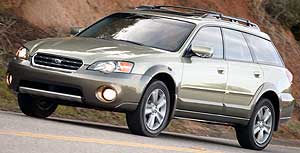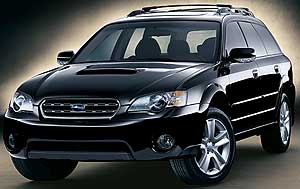2005 Subaru Outback Program #2343
Subaru’s original Outback set the standard for today’s crossover vehicle segment as the first sport-utility ‘‘wagon.’’ But in the almost 10 years since the Outback arrived, rivals have produced some pretty impressive crossover vehicles of their own. So, for 2005, Subaru counterattacks with an all-new Outback. It’s larger, sleeker, and more powerful. But does this new go-anywhere wagon have what it takes to lead the crossover movement?
In an aim to keep its leadership status, Subaru has totally redesigned the 2005 Outback, both inside and out. And it’s the outside that really grabs your attention, being much more refined and detailed than that of its predecessor. With a basic body shell shared with the also all-new Legacy, the more aerodynamic nose of our XT-Grade Outback adds a well integrated and functional hood scoop, the lines sweep along smoother flanks with larger wheel arches and slimmer protective body cladding, plus new side mirrors with integrated turn signals, and back to a slicker tail with larger rear lamps and a more aggressive spoiler mounted atop the lift gate.
It’s a cleaner, leaner look that goes well with weight savings of almost 200-pounds, depending on which model you choose, and that’s despite the new car gaining almost an inch in wheelbase and two inches of overall length.
All Legacy and Outbacks use Subaru’s super-solid Ring Shaped Safety Structure, which is lighter and stronger for 2005 and ride on an upgraded MacPherson strut front/multi-link rear suspension, which is supported by 16-inch alloy wheels for the 2.5i, or larger 17-inch wheels for the 2.5 XT and the 3.0 R models.
 Two engine families power the new Outback, a 2.5-liter flat-four and a 3.0-liter flat-six. The normally aspirated four is slightly up-rated to168-horsepower and 168 pound-feet of torque. New to the Outback is the turbocharged 2.5, pumping out 250 horsepower and 250 pound-feet of torque. It’s a great alternative to the larger six also with 250 horsepower, but a more modest 219 pound-feet. They drive a 5-speed manual, 4-speed automatic, or for the 2.5 XT and 3.0 R, a new 5-speed automatic transmission with manual shift mode.
Two engine families power the new Outback, a 2.5-liter flat-four and a 3.0-liter flat-six. The normally aspirated four is slightly up-rated to168-horsepower and 168 pound-feet of torque. New to the Outback is the turbocharged 2.5, pumping out 250 horsepower and 250 pound-feet of torque. It’s a great alternative to the larger six also with 250 horsepower, but a more modest 219 pound-feet. They drive a 5-speed manual, 4-speed automatic, or for the 2.5 XT and 3.0 R, a new 5-speed automatic transmission with manual shift mode.
As always, the Outback is propelled through adversity by one of Subaru’s five proven full-time all-wheel-drive systems. Outback variations include the Variable Torque Distribution system for the 5-speed transmission cars, and the 3.0 R model’s VDC version that includes both traction and stability control. Outback ground clearance is a generous 8.7 inches, or over 2.5 inches more than the Legacy.
With our test 2.5 XT’s automatic transmission in manual mode, the Outback hit 60 in 6.8 seconds. The quarter mile ran out in 15.2 seconds at 94 miles-per-hour. That’s almost two seconds quicker to 60 than any previous Outback, and a full second quicker through the quarter mile. The engine feels soft off the line, but then hits hard at 3,500 rpm as the turbo pressure builds. Throttle response also quickens as power builds, all the way to the 6,500 rpm redline. While a bit buzzy when making power, the new engine is smoother than last year’s 2.5, and most other fours.
As with most crossover vehicles, the Outback feels a bit loose in corners. But that feel is deceiving, as grip levels are always high, and the variable-speed rack-and-pinion steering always responsive. Front plow is very mild. There is a fair bit of body roll, but the tail slides loose in a very predictable manner. It’s actually quite entertaining for a people mover.
Braking, however, was a disappointment, with stops from 60 averaging a long 155 feet. This despite 4-wheel discs with ABS and Electronic Brake Force Distribution. The brake pedal felt very soft with little feedback. But stability was not a problem, with all stops straight and true.
In daily driving, the Outback delivered a solid, refined ride that is closer to a pure luxury car than ever before. Interior noise levels are also lower, adding to the high end feel. As does the new cabin, which boasts a cleaner look, and much improved fit and finish.
Our biggest complaint of the previous Outback was the marginal long distance seat comfort. Our impressions are that it is also vastly improved. Dash materials have gone from a utilitarian to premium look, yet it retains the simple practicality that Subarus have always been known for, and a standard equipment list that in our 2.5 XT includes dual zone climate controls and a CD stereo with 6-disc changer. As well as safety features like standard side impact and head curtain airbags. But note Subaru has recalled early ‘05 Outbacks and Legacys to check curtain airbag operation. Our XT also included a dual-panel moon roof that lets in all the light that you could possibly need.
Rear seat hip and head room are improved, and the 60/40 split folding seat backs remain. With seats up, the cargo area is a healthy 33.5 cubic-feet, while doubling to 66.2 cubic-feet with them down.
Fuel economy estimates for our 2.5 XT auto are 19 city and 24 highway. Expect a respectable 21 miles per gallon.
Outback Wagon prices are little changed for 2005. The entry 2.5i begins at $24,570. Our 2.5 XT test car starts at $28,570, with 6-cylinder models at $32,770 and up.
The Subaru Outback is the original go-anywhere crossover wagon. Yet its competition grows more capable every year. Still with the arrival of the new 2005 Outback, we don’t think that Subaru will relinquish its position as leader of the crossover segment anytime soon.
Specifications
- Engine: Turbocharged 2.5-Liter Flat-four
- Horsepower: 250
- Torque: 250 Lb Feet
- 0-60 MPH: 6.8 Seconds
- 1/4 Mile: 15.2 Seconds @ 94 MPH
- 60-0 MPH: 155 Feet
- EPA Mileage: 19 MPG City 24 MPG Highway
- Motorweek's Mileage Loop: 21 MPG Mixed City/highway






